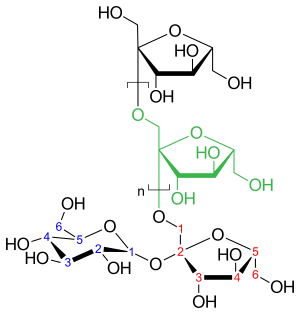
Back إينولين Arabic اینولین AZB Інулін Byelorussian Інулін BE-X-OLD Инулин Bulgarian ইনুলিন Bengali/Bangla Inulin BS Inulina Catalan Inulin Czech Inulin Danish

| |
| Identifiers | |
|---|---|
| ChEMBL | |
| ChemSpider |
|
| DrugBank | |
| ECHA InfoCard | 100.029.701 |
| KEGG | |
PubChem CID
|
|
| UNII | |
CompTox Dashboard (EPA)
|
|
| Properties | |
| C6nH10n+2O5n+1 | |
| Molar mass | Polymer; depends on n |
| Pharmacology | |
| V04CH01 (WHO) | |
| Hazards | |
| NFPA 704 (fire diamond) | |
Except where otherwise noted, data are given for materials in their standard state (at 25 °C [77 °F], 100 kPa).
| |
Inulins are a group of naturally occurring polysaccharides produced by many types of plants,[1] industrially most often extracted from chicory.[2] The inulins belong to a class of dietary fibers known as fructans. Inulin is used by some plants as a means of storing energy and is typically found in roots or rhizomes. Most plants that synthesize and store inulin do not store other forms of carbohydrate such as starch. In the United States in 2018, the Food and Drug Administration approved inulin as a dietary fiber ingredient used to improve the nutritional value of manufactured food products.[3] Using inulin to measure kidney function is the "gold standard" for comparison with other means of estimating glomerular filtration rate.[4]
- ^ Cite error: The named reference
Roberfroid 2003 13–26was invoked but never defined (see the help page). - ^ Roberfroid M. B. (2007). "Inulin-type fructans: functional food ingredients". Journal of Nutrition. 137 (11 suppl): 2493S–2502S. doi:10.1093/jn/137.11.2493S. PMID 17951492.
- ^ "The Declaration of Certain Isolated or Synthetic Non-Digestible Carbohydrates as Dietary Fiber on Nutrition and Supplement Facts Labels: Guidance for Industry" (PDF). US Food and Drug Administration. 14 June 2018. Retrieved 15 June 2018.
- ^ Hsu, C. Y.; Bansal, N. (August 2011). "Measured GFR as 'gold standard'—all that glitters is not gold?". Clinical Journal of the American Society of Nephrology. 6 (8): 1813–1814. doi:10.2215/cjn.06040611. PMID 21784836.
